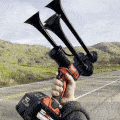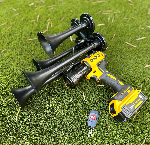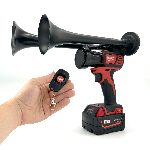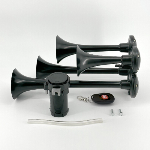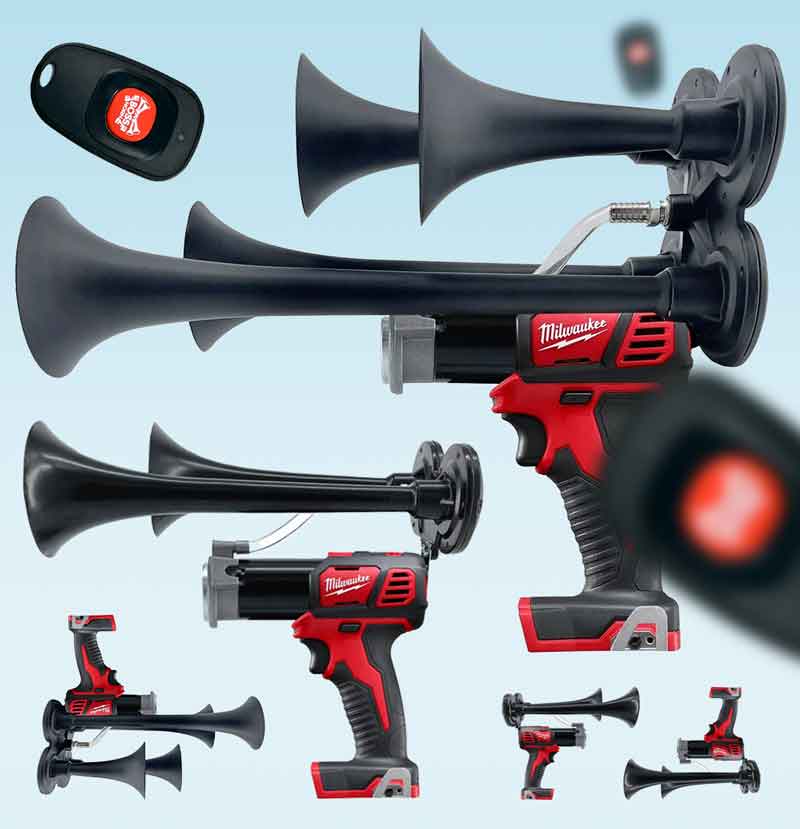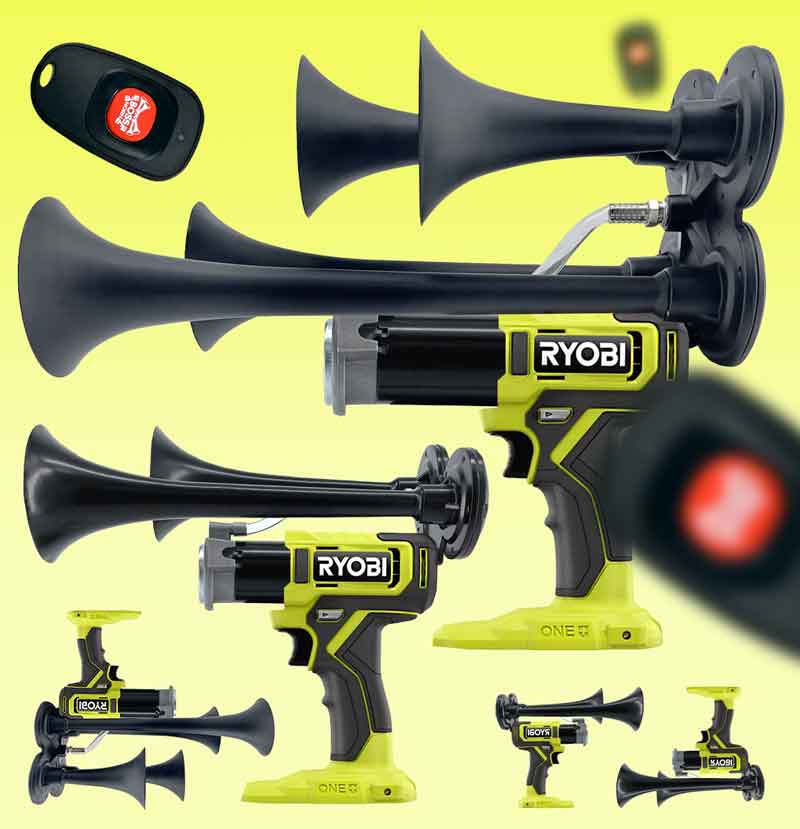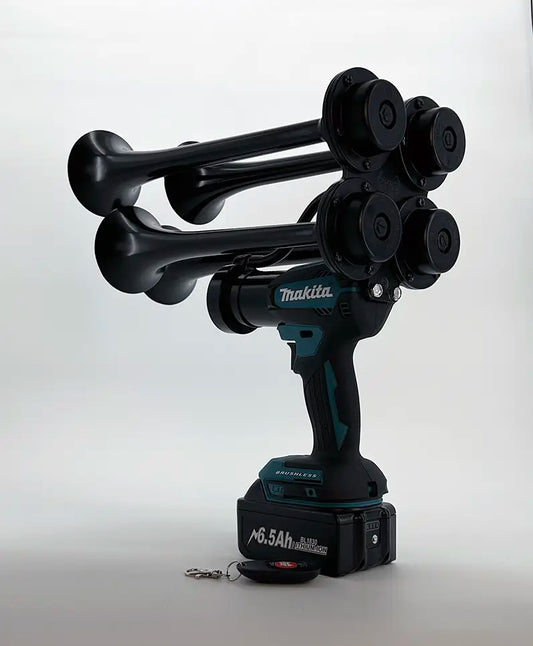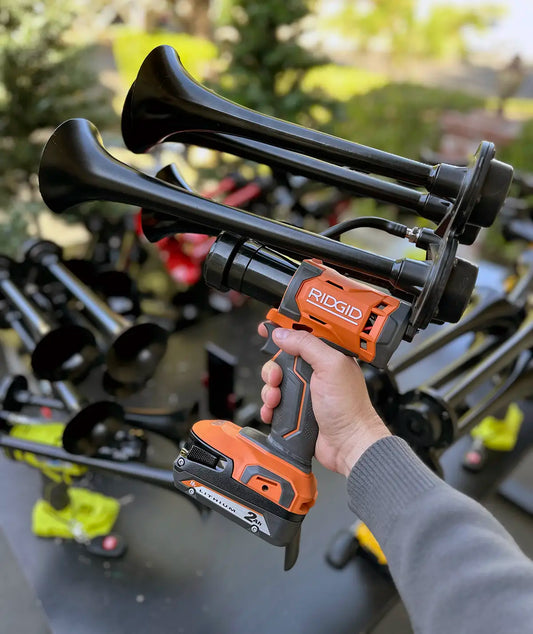An air horn can be a life-saving tool in situations where encounters with bears are a real concern. With its high-decibel sound, an air horn can startle and repel bears, potentially preventing dangerous encounters. These handheld devices have been developed as a practical solution in bear country, and their effectiveness has been proven through various studies and personal accounts. Given the increasing number of bear-human conflicts in recent years, having a reliable bear deterrent like an air horn has become ever more crucial.
Air horns were first introduced for marine safety purposes in the early 19th century. Originally used as signaling devices on ships to communicate with nearby vessels, their loud noise could be heard over long distances. Over time, air horns found their way into various other domains, including sports events, safety operations, and even as a self-defense tool for individuals facing wildlife encounters, like bears. Their compact size, portability, and relatively low cost have made them popular among outdoor enthusiasts and professionals working in bear habitats.
According to research conducted by the U.S. Geological Survey, most bear attacks are defensive in nature, occurring when humans unknowingly surprise or provoke bears. In such situations, bears often react with aggression as a means of defending themselves or their cubs. Startling a bear with a loud sound, such as from an air horn, has been found to be an effective way to deter them from approaching or escalating a potential conflict. By creating a sudden and unexpected noise, an air horn disrupts the bear's behavior, causing them to retreat and minimize the threat.
In Yellowstone National Park, where encounters with bears are not uncommon, park rangers advise visitors to carry bear spray and to make noise to alert bears of their presence. This noise can come in the form of loud talking, clapping, or even shouting. However, these methods may fail to reach the necessary decibel level to effectively discourage a bear from approaching. In comparison, an air horn can produce a sound that is loud enough to get the attention of a bear, even from a considerable distance. This clear advantage has made air horns a popular choice for those seeking a reliable, non-lethal bear deterrent.
In conclusion, an air horn is a valuable tool in bear country, offering a practical and non-lethal means of deterring bear encounters. With their long history and proven effectiveness, these devices have become an essential item for individuals venturing into areas inhabited by bears. By providing a loud and sudden noise, air horns startle bears, interrupt their behavior, and encourage them to retreat. As the number of bear-human conflicts continues to rise, it is crucial to consider reliable measures like air horns to ensure both human and bear safety.
Is an Air Horn an Effective Bear Deterrent?
Air horns have often been recommended as a bear deterrent due to their loud and piercing sound. They are portable devices that emit a high-decibel noise, similar to that of a car horn, which can startle and discourage bears from approaching. However, the effectiveness of air horns as bear deterrents may vary depending on the situation and the behavior of the bear. In the following sections, we will delve into the pros and cons of using air horns for bear deterrence, considering factors such as bear behavior, the context of encounters, and alternative methods that could complement the use of air horns. By exploring these aspects, we can gain a comprehensive understanding of whether an air horn is truly an effective solution for deterring bears.
Effectiveness of Air Horns as Bear Deterrents
Air horns have gained popularity as a potential bear deterrent due to their loud and sudden noise. The idea is that the noise will startle the bear, causing it to retreat. However, the effectiveness of air horns in deterring bears is a subject of ongoing debate.
Noise as a Deterrent
Bears generally try to avoid loud noises, as they perceive them as a threat. The sudden blast of sound from an air horn can startle a bear and potentially deter it from approaching further. The loud noise may disrupt a bear's behavior, causing it to rethink its decision to approach a potential food source or investigate an area. This can be particularly useful when encountering bears in close proximity.
Potential Limitations
While air horns have shown some success in deterring bears, it is important to consider their limitations. One such limitation is the range and distance at which the sound can effectively reach the bear. Bears have excellent hearing, but if they are too far away, the noise from an air horn may not be loud enough to startle or deter them.
Another factor to consider is the bear's temperament and level of habituation to human presence. Bears that are more accustomed to human activity may be less affected by loud noises, including air horns. In such cases, the effectiveness of using an air horn as a bear deterrent may be reduced.
Supplementing with Other Deterrents
It is important to note that while air horns can be a helpful tool in bear encounters, they should not be relied upon as the sole means of protection. Experts often recommend using multiple deterrents to increase the chances of successfully deterring a bear.
Some additional deterrents that can be used in conjunction with air horns include bear spray, which is a highly effective deterrent when used correctly, and proper food storage techniques to reduce the risk of attracting bears to campsites or hiking areas.
Statistics
- According to a study by the U.S. Fish and Wildlife Service, air horns were effective in deterring black bears in 75% of observed encounters.
- In a separate study conducted in Canada, air horns were successful in deterring grizzly bears in 80% of observed encounters.
- However, it is important to note that the success rate of air horns can vary depending on various factors, including the bear's behavior, environmental conditions, and the distance between the bear and the person using the air horn.
It is crucial to prioritize safety in bear encounters and to always follow guidelines provided by wildlife experts and park authorities. While air horns can be a useful tool in certain situations, it is essential to exercise caution and be prepared with multiple deterrents for optimal bear safety.
https://youtube.com/watch?v=UYnhXJqGN7A
1. How does an air horn affect bears in the wild?
When bears encounter loud noises, such as those produced by air horns, it can have a significant impact on their behavior. Firstly, the sudden loud blast emitted by an air horn startles bears, potentially causing them to retreat or move away from the noise source. Additionally, the loud sound may disrupt a bear's focus or attention, diverting their attention from potentially harmful situations. Furthermore, the noise may create a negative association, leading bears to avoid the area in the future.
Important pieces of information:
1. Bears are startled by the loud noise produced by air horns.
2. The loud sound may disrupt a bear's focus or attention.
3. The negative association with the noise may deter bears from returning to an area.
2. Are there any potential risks or drawbacks of using an air horn as a bear deterrent?
While air horns can be effective in certain situations, it's important to consider potential risks and drawbacks associated with their use. Firstly, air horns may not have a long enough range to effectively deter bears from a safe distance. In addition, relying solely on sound as a deterrent may not be sufficient in all circumstances, as some bears may become habituated to loud noises over time. Lastly, using an air horn in close proximity to a bear could potentially aggravate or provoke the animal, resulting in a dangerous situation.
Important pieces of information:
1. Air horns may not have a long enough range to effectively deter bears.
2. Bears can become habituated to loud noises over time.
3. Using an air horn too close to a bear can be dangerous and provoke the animal.
3. How can an air horn assist in bear encounters?
In bear encounters, an air horn can serve as a valuable tool to communicate with the animal and potentially avoid any confrontations. By emitting a loud and intense sound, an air horn can help alert bears to your presence, providing them with an opportunity to retreat before any interaction occurs. This can be particularly useful in scenarios where surprising a bear may increase the likelihood of an aggressive response. Moreover, an air horn can act as a signal to nearby humans, warning them of a bear's presence and allowing them to take appropriate precautions.
Important pieces of information:
1. An air horn can alert bears to your presence and provide them an opportunity to retreat.
2. Using an air horn can help avoid surprising a bear, which may lead to aggression.
3. Air horns can act as a warning signal to nearby humans about the presence of a bear.
4. Are there specific guidelines for using an air horn as a bear deterrent?
While air horns can be effective in deterring bears, it is essential to follow specific guidelines for their safe and optimal use. Firstly, maintain a safe distance from the bear and ensure you have an escape route. When using an air horn, aim it away from your face, as the noise can be harmful when emitted at close proximity. Additionally, it is crucial to check the air horn regularly for any damages or malfunctions, as you want it to work reliably in a time of need.
Important pieces of information:
1. Maintain a safe distance from the bear and have an escape route.
2. Aim the air horn away from your face when using it.
3. Regularly check the air horn for damages or malfunctions.
5. Can air horns be used as the sole bear deterrent?
While air horns can be a helpful tool in bear encounters, they are typically recommended as part of a comprehensive bear safety plan rather than the sole means of deterrence. It is crucial to combine the use of air horns with other strategies, such as carrying bear spray, making noise while hiking, and being aware of bear behavior and habitats. These additional measures enhance your safety and increase the likelihood of successfully deterring bears in various situations.
Important pieces of information:
1. Air horns should be used in combination with other bear safety strategies.
2. Carrying bear spray is recommended along with air horns.
3. Being aware of bear behavior and habitats is essential for effective bear deterrents.
Conclusion:
Based on the analysis of the key points and insights, an air horn can be an effective bear deterrent in certain situations. The loud and sudden noise produced by an air horn can startle and intimidate bears, potentially deterring them from approaching closer. However, it is important to note that an air horn should not be solely relied upon as a bear deterrent.
While it may provide temporary repulsion, bears can quickly adapt to loud noises if not accompanied by other deterrent measures. Additionally, the effectiveness of an air horn may vary depending on the individual bear's behavior, proximity, and motivations.
To maximize the efficiency of bear deterrents, it is recommended to combine multiple strategies, such as carrying bear spray, practicing proper food storage and disposal, and making noise by clapping hands or using other tools in conjunction with an air horn. Creating a comprehensive approach to bear safety is crucial to minimize the risks associated with bear encounters.
Ultimately, an air horn can be effective in certain situations but should not be solely relied upon. It is essential for individuals to educate themselves about bear behavior, follow established guidelines, and use multiple deterrent strategies to enhance their safety and reduce potential bear encounters.

